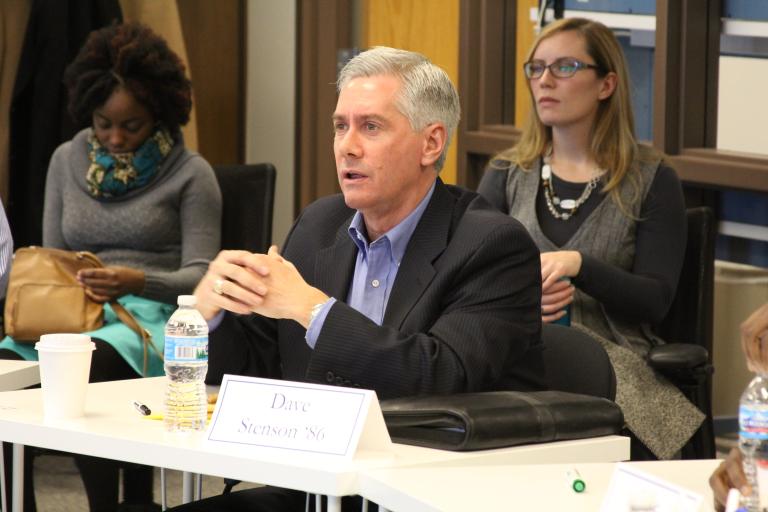
“The retail customer isn’t going to be the first place where transportation electrification is going to take place in high volume.”
The next generation of electric vehicles are hitting the market in a fury with uncertain results, but Dave Stenson ‘86 thinks the electric revolution won’t occur first with cars at all. Instead, Stenson, the Founder and CEO of Inventev, believes that the renaissance will start elsewhere, mainly in multi-function fleet vehicles.
“The electrification of transportation is a very difficult value proposition for the average customer given the cost of the technology,” Stenson said. “Based on the expertise of our team, it appears as though the retail customer isn’t going to be the first place where transportation electrification is going to take place in high volume.”
Stenson is looking at hybridizing medium duty classes 2B to 5 trucks. This would include smaller delivery trucks, electric utility and telecom service “aerial bucket” trucks and other trucks that you might see plumbers or electricians use.
Stenson has discovered and evaluated the potential of this market after spending 29 years working for General Motors (GM) before venturing off on this entrepreneurial pursuit.
The Next Generation of Electric
Stenson graduated from Kettering after completing his co-op at GM’s Warren Tech Center. He continued working for GM in a variety of capacities ranging from being the Pontiac Solstice Vehicle Line Director, the Chief Engineer running GM’s Toluca, Mexico, engineering center in the mid-1990s to Chief Technical Officer for the HUMMER spin-off deal team in 2009-10. In his final year at GM, Stenson started investigating the hybridization and electrification of vehicles in an effort to make HUMMER a standalone product line.
“When I left General Motors, I kept thinking where electrification technology can be best applied,” Stenson said. “I started looking at the commercial fleet space as a market specifically because I did not want to overlap with the core markets of the larger automakers and at the same time offer work truck benefits that can payback over the typically 10-year life in a fleet.”
After identifying fleet vehicles as a potential niche market, Stenson founded Inventev to design an innovative plug-in hybrid electric vehicle (PHEV) commercial truck which provides mobility and mobile power generation capacity.
Pacific Gas and Electric Company (PG&E) in California is one of the largest combination natural gas and electric utilities in the United States and are early collaborators in Inventev’s technology. PG&E believes that by incorporating Inventev’s innovative fleet vehicle technology they will be able to better manage costs and provide more efficient grid maintenance by responding to power outages and emergencies faster.
Stenson’s technology, which integrates electric motors into the transmission to best optimize the use of stored grid power, will help PG&E accomplish these goals.
“It’s the intersect between vehicles and the energy space,” Stenson said. “We thought that adding value propositions in addition to mobility was a near-term solution to provide customers with viable payback.”
The vehicles are called “Energy SWAT Trucks” and they can generate utility-grade power for a neighborhood (such as for storm resiliency) using the same core components that move the vehicle electrically.
Stenson participated in an event sponsored by The Hill entitled, “The Next generation of Electric Transportation: Innovation in Technology & Power,” in November 2014 in Washington D.C. During the event, Stenson nationally declared his belief that the electrification of vehicles will accelerate in niche markets such as fleet vehicles rather than en masse with large automakers in retail passenger vehicles.
“I think in the last five years, there’s been a lot of experimentation particularly with regard to electrification,” said Stenson, during the event. “Keep in mind, the bread and butter of the auto industry is high volume, it’s not niche plays. At this point they view electrification as a niche play.”
Stenson and his team members have also done some collaborative work with Kettering’s Advanced Power Electronics Laboratory (APEL) under Dr. Kevin Bai and won the Transportation Sector $25,000 top prize at the Accelerate Michigan Innovation Competition in fall 2014.
In January 2016, Inventev was awarded a $500,000 grant from the U.S. Department of Energy’s Advanced Research Projects Agency-Energy (ARPA-E) to continue developing concepts and innovations alongside Bai.
“We’re hoping to be able to have a working demonstration soon,” Stenson said. “We are optimistic that it will result from a combination of public and private funding.”